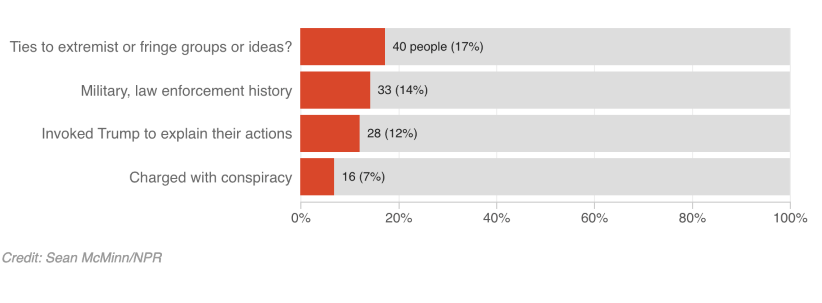The Capitol Siege: The Arrested To Date
There are at least six databases listing the names and charges against those involved in the January 6 riots at the U.S. Capitol.
All take slightly different slices of the apple. They have different total numbers for those arrested or charged (due to how frequently they are updated). They have different options for searching the charges. Some recap highlights or key takeaways from the total charges and individuals in their listing. Others just offer the data. Some are graphically inviting. Others present little more than an online spreadsheet.
NPR is solidly in the mix with its database that accompanies its audio story, “The Capitol Siege: The Arrested and Their Stories.” Developed by NPR’s Investigations and Apps team, the effort follows some useful NPR databases built in recent months around COVID19 cases, vaccinations and vaccine delivery. They also spring from NPR’s 2015 award-winning database of World War II vets exposed to mustard gas.
“More enterprise investigations that use databases are in the works,” said NPR spokesperson Allyssa Pollard. That would be a promising development for public media’s future accountability journalism, which is often built on data.
As of Tuesday, NPR’s database identified 231 suspects in the breach of the Capitol.
“A group this large defies generalization. The defendants are predominantly white and male, though there were exceptions. Federal prosecutors say a former member of the Latin Kings gang joined the mob, as did two Virginia police officers. A man in a ‘Camp Auschwitz’ sweatshirt took part, as did a Messianic Rabbi. Far-right militia members decked out in tactical gear rioted next to a county commissioner, a New York City sanitation worker, and a two-time Olympic gold medalist,” NPR reported.
“Sixteen are accused of committing conspiracy, one of the most serious charges brought. Twenty-eight are accused of committing acts of violence, particularly against Capitol Police. At least 32 are suspected of causing property damage, like breaking windows or doors to gain entry to the building, or theft, like the man photographed carrying House Speaker Nancy Pelosi's lectern or one woman who allegedly took a laptop from Pelosi's office.”

NPR lists a suspect’s name, age, and state, with a photo, and offers a summary of that person’s involvement and a list of charges with a link to the charging documents. I particularly like that one can search the NPR database not only by a defendant’s state and the charges filed but also whether he or she had any military or law enforcement ties, or ties to an extremist or fringe group; this information is also in the New York Times’ database. Unique to NPR is information on whether a suspect said he was incited to participate on January 6 by former President Trump.

You can compare NPR’s efforts with some of the other January 6 arrest databases:
- USA Today lists 222 people arrested or charged by either federal prosecutors or Capitol and DC Metro Police, identifying the person by photo (if available), age, date charged, and home state. One can search the accused by name or state. There are also links to news articles about local suspects.
- Insider.com, an affiliate of Business Insider, listed 259 people as of Tuesday in a table identifying name, age, state, charges and “details” of that suspect’s involvement.
- The U.S. Attorney’s Office of the District of Columbia, offers a spreadsheet that includes case number; name of the individual; charges; accompanying documents, such as an indictment or complaint; location of the arrest; case status and case updates.
- George Washington University’s Program on Extremism, identifies 212 arrestees, broken down by federal and non-federal cases. It reports in a graphic that the average age of those charged is 39; they came from 40 states and D.C.; and there are, so far, 189 men and 29 women.
- The New York Times’ database listed only 175 people as of last week. It is, however, the most graphically attractive, including available photos, It groups arrests by the type of charges, for instance, conspiracy or assault (26); interference with law enforcement or weapons charges (43); or trespassing or disrupting Congress (107).
More participants in the January 6 breach of the Capitol are still expected to be charged and will be added to these listings.
It should noted that there is at least one other enterprising database relating to the day’s events. That is ProPublica’s ambitious timeline of more than 500 videos recovered from the largely pro-Trump social platform Parler.
I extend kudos to NPR’s Capitol arrests and other databases. But, as evergreen as they are, one could not easily find them in a search on NPR.org. A “databases” link in the navigation bar’s drop-down menu would extend the value proposition of these labor-intensive efforts.
I also hope, going forward, that, as much as NPR attends to sound in crafting an audio story, it would develop keener visualization abilities for its data offerings. I think the audience would welcome it.
Finally, I’d offer an idea for NPR’s newly created Stations Investigations Team, working to help local public radio stations: There is hefty fodder in these national databases to localize a statewide or regional list of arrestees. Just take a look at the database of Capitol arrests in New York State developed by syracuse.com and consider replicating it.
You can subscribe to CPB Ombudsman Reports at https://www.cpb.org/subscribe. Read more CPB Ombudsman Reports here.


